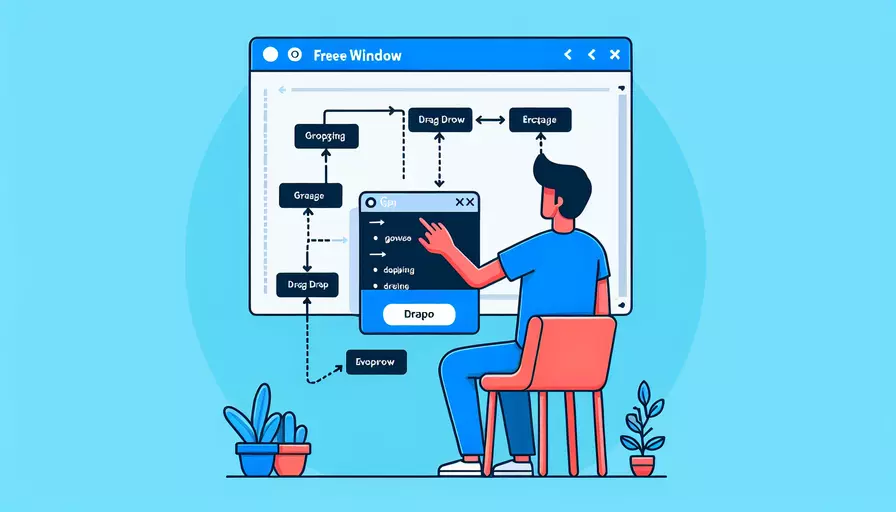
在Vue中实现窗口自由拖拽有多种方法,主要步骤包括1、设置窗口的样式和结构,2、添加拖拽事件,3、计算并更新窗口的位置。以下是详细的实现过程。
一、设置窗口的样式和结构
首先,我们需要在Vue组件中定义一个可拖拽的窗口,并为其设置必要的样式。可以使用HTML和CSS来实现:
<template>
<div class="draggable-window" ref="draggableWindow">
<div class="header" ref="header">
<h3>可拖拽窗口</h3>
</div>
<div class="content">
<p>这里是窗口的内容。</p>
</div>
</div>
</template>
<style scoped>
.draggable-window {
width: 300px;
height: 200px;
background-color: #fff;
border: 1px solid #ddd;
position: absolute;
top: 50px;
left: 50px;
box-shadow: 0 0 10px rgba(0, 0, 0, 0.1);
}
.header {
background-color: #f0f0f0;
padding: 10px;
cursor: move;
}
.content {
padding: 20px;
}
</style>
二、添加拖拽事件
然后,我们需要在Vue组件中添加拖拽事件来处理窗口的位置更新。可以通过监听mousedown、mousemove和mouseup事件来实现拖拽功能。
<script>
export default {
mounted() {
const header = this.$refs.header;
const draggableWindow = this.$refs.draggableWindow;
header.addEventListener('mousedown', this.onMouseDown);
},
methods: {
onMouseDown(event) {
const draggableWindow = this.$refs.draggableWindow;
const offsetX = event.clientX - draggableWindow.offsetLeft;
const offsetY = event.clientY - draggableWindow.offsetTop;
const onMouseMove = (event) => {
draggableWindow.style.left = `${event.clientX - offsetX}px`;
draggableWindow.style.top = `${event.clientY - offsetY}px`;
};
const onMouseUp = () => {
document.removeEventListener('mousemove', onMouseMove);
document.removeEventListener('mouseup', onMouseUp);
};
document.addEventListener('mousemove', onMouseMove);
document.addEventListener('mouseup', onMouseUp);
}
}
}
</script>
三、计算并更新窗口的位置
在鼠标拖动过程中,持续更新窗口的位置。我们需要确保窗口不会超出可视区域的范围。
methods: {
onMouseDown(event) {
const draggableWindow = this.$refs.draggableWindow;
const offsetX = event.clientX - draggableWindow.offsetLeft;
const offsetY = event.clientY - draggableWindow.offsetTop;
const onMouseMove = (event) => {
let newLeft = event.clientX - offsetX;
let newTop = event.clientY - offsetY;
// 确保窗口不会超出可视区域
newLeft = Math.max(0, Math.min(newLeft, window.innerWidth - draggableWindow.clientWidth));
newTop = Math.max(0, Math.min(newTop, window.innerHeight - draggableWindow.clientHeight));
draggableWindow.style.left = `${newLeft}px`;
draggableWindow.style.top = `${newTop}px`;
};
const onMouseUp = () => {
document.removeEventListener('mousemove', onMouseMove);
document.removeEventListener('mouseup', onMouseUp);
};
document.addEventListener('mousemove', onMouseMove);
document.addEventListener('mouseup', onMouseUp);
}
}
四、进一步优化
为了提升用户体验,可以添加一些额外的功能,如防止窗口闪烁、增加拖拽手柄等。
-
防止窗口闪烁:在拖拽过程中,可能会出现窗口闪烁的现象。可以通过添加CSS样式来优化:
.draggable-window {transition: none;
}
-
增加拖拽手柄:可以为窗口添加一个拖拽手柄,用户可以通过拖拽手柄来移动窗口,而不是整个窗口区域:
<div class="header" ref="header"><div class="drag-handle" ref="dragHandle">拖拽</div>
<h3>可拖拽窗口</h3>
</div>
.drag-handle {width: 100%;
height: 10px;
background-color: #ccc;
cursor: move;
}
总结
通过以上步骤,我们可以在Vue中实现窗口自由拖拽功能。主要步骤包括1、设置窗口的样式和结构,2、添加拖拽事件,3、计算并更新窗口的位置。在实际应用中,可以根据具体需求进行进一步优化和扩展。例如,可以添加拖拽手柄、优化窗口闪烁问题等。希望这些内容能够帮助你更好地理解和实现Vue中的窗口自由拖拽功能。如果你有更多需求,可以进一步查阅相关文档或社区资源。
相关问答FAQs:
1. Vue如何实现窗口自由拖拽的功能?
要实现窗口的自由拖拽功能,可以使用Vue的指令和事件绑定来实现。下面是一个简单的示例代码:
<template>
<div class="window" v-draggable>
<!-- 窗口内容 -->
</div>
</template>
<script>
export default {
directives: {
draggable: {
bind(el) {
el.style.position = 'absolute';
el.style.cursor = 'move';
el.addEventListener('mousedown', startDrag);
},
unbind(el) {
el.removeEventListener('mousedown', startDrag);
}
}
}
};
function startDrag(e) {
const window = e.target;
const startX = e.clientX;
const startY = e.clientY;
const startLeft = window.offsetLeft;
const startTop = window.offsetTop;
document.addEventListener('mousemove', doDrag);
document.addEventListener('mouseup', stopDrag);
function doDrag(e) {
const deltaX = e.clientX - startX;
const deltaY = e.clientY - startY;
window.style.left = `${startLeft + deltaX}px`;
window.style.top = `${startTop + deltaY}px`;
}
function stopDrag() {
document.removeEventListener('mousemove', doDrag);
document.removeEventListener('mouseup', stopDrag);
}
}
</script>
<style scoped>
.window {
width: 200px;
height: 200px;
background-color: #f0f0f0;
}
</style>
在上面的代码中,我们定义了一个名为draggable的指令。在指令的bind钩子函数中,我们设置了窗口的position为absolute,并添加了mousedown事件监听器。当用户按下鼠标时,会触发startDrag函数。
startDrag函数中,我们记录了鼠标按下时的坐标和窗口的初始位置。然后,我们在document上绑定了mousemove和mouseup事件监听器,分别用于拖拽窗口和停止拖拽。
在doDrag函数中,我们计算鼠标的偏移量,并根据偏移量来更新窗口的位置。最后,在stopDrag函数中,我们移除了事件监听器,停止拖拽。
通过以上的代码,我们就可以在Vue中实现窗口的自由拖拽功能。
2. 如何限制窗口在指定区域内拖拽?
如果想要限制窗口在指定区域内进行拖拽,可以在拖拽过程中对窗口的位置进行限制。下面是一个示例代码:
<template>
<div class="container" v-draggable>
<div class="window">
<!-- 窗口内容 -->
</div>
</div>
</template>
<script>
export default {
directives: {
draggable: {
bind(el) {
el.style.position = 'absolute';
el.style.cursor = 'move';
el.addEventListener('mousedown', startDrag);
},
unbind(el) {
el.removeEventListener('mousedown', startDrag);
}
}
}
};
function startDrag(e) {
const container = e.currentTarget;
const window = e.target;
const startX = e.clientX;
const startY = e.clientY;
const startLeft = window.offsetLeft;
const startTop = window.offsetTop;
const containerRect = container.getBoundingClientRect();
document.addEventListener('mousemove', doDrag);
document.addEventListener('mouseup', stopDrag);
function doDrag(e) {
const deltaX = e.clientX - startX;
const deltaY = e.clientY - startY;
const left = startLeft + deltaX;
const top = startTop + deltaY;
if (left < containerRect.left) {
window.style.left = `${containerRect.left}px`;
} else if (left + window.offsetWidth > containerRect.right) {
window.style.left = `${containerRect.right - window.offsetWidth}px`;
} else {
window.style.left = `${left}px`;
}
if (top < containerRect.top) {
window.style.top = `${containerRect.top}px`;
} else if (top + window.offsetHeight > containerRect.bottom) {
window.style.top = `${containerRect.bottom - window.offsetHeight}px`;
} else {
window.style.top = `${top}px`;
}
}
function stopDrag() {
document.removeEventListener('mousemove', doDrag);
document.removeEventListener('mouseup', stopDrag);
}
}
</script>
<style scoped>
.container {
width: 500px;
height: 500px;
border: 1px solid #ccc;
position: relative;
}
.window {
width: 200px;
height: 200px;
background-color: #f0f0f0;
}
</style>
在上面的代码中,我们在指令的bind钩子函数中,添加了一个名为container的容器元素,并记录了容器的位置信息。
在doDrag函数中,我们通过比较窗口的位置与容器的位置,来限制窗口的拖拽范围。如果窗口超出了容器的边界,我们将窗口的位置调整到边界上。
通过以上的代码,我们就可以实现窗口在指定区域内的自由拖拽功能。
3. 如何实现窗口拖拽时的平滑过渡效果?
要实现窗口拖拽时的平滑过渡效果,可以使用Vue的过渡动画。下面是一个示例代码:
<template>
<div class="window" v-draggable>
<!-- 窗口内容 -->
</div>
</template>
<script>
export default {
directives: {
draggable: {
bind(el) {
el.style.position = 'absolute';
el.style.cursor = 'move';
el.addEventListener('mousedown', startDrag);
},
unbind(el) {
el.removeEventListener('mousedown', startDrag);
}
}
}
};
function startDrag(e) {
const window = e.target;
const startX = e.clientX;
const startY = e.clientY;
const startLeft = window.offsetLeft;
const startTop = window.offsetTop;
const containerRect = window.parentNode.getBoundingClientRect();
document.addEventListener('mousemove', doDrag);
document.addEventListener('mouseup', stopDrag);
function doDrag(e) {
const deltaX = e.clientX - startX;
const deltaY = e.clientY - startY;
const left = startLeft + deltaX;
const top = startTop + deltaY;
if (left < containerRect.left) {
window.style.left = `${containerRect.left}px`;
} else if (left + window.offsetWidth > containerRect.right) {
window.style.left = `${containerRect.right - window.offsetWidth}px`;
} else {
window.style.left = `${left}px`;
}
if (top < containerRect.top) {
window.style.top = `${containerRect.top}px`;
} else if (top + window.offsetHeight > containerRect.bottom) {
window.style.top = `${containerRect.bottom - window.offsetHeight}px`;
} else {
window.style.top = `${top}px`;
}
}
function stopDrag() {
document.removeEventListener('mousemove', doDrag);
document.removeEventListener('mouseup', stopDrag);
window.style.transition = 'left 0.3s, top 0.3s';
window.style.left = window.style.left;
window.style.top = window.style.top;
window.addEventListener('transitionend', resetTransition);
}
function resetTransition() {
window.style.transition = '';
window.removeEventListener('transitionend', resetTransition);
}
}
</script>
<style scoped>
.window {
width: 200px;
height: 200px;
background-color: #f0f0f0;
transition: left 0.3s, top 0.3s;
}
</style>
在上面的代码中,我们在指令的unbind钩子函数中,添加了过渡动画的相关代码。当停止拖拽时,我们给窗口添加了过渡效果的样式,并在transitionend事件中移除过渡效果的样式。
通过以上的代码,我们就可以实现窗口拖拽时的平滑过渡效果。
文章标题:vue如何实现窗口自由拖拽,发布者:飞飞,转载请注明出处:https://worktile.com/kb/p/3654852

 微信扫一扫
微信扫一扫  支付宝扫一扫
支付宝扫一扫 